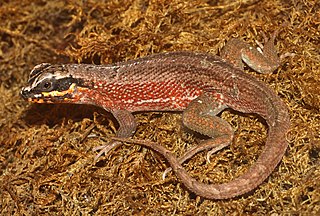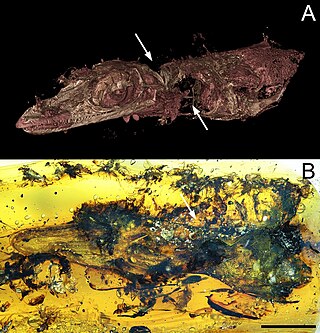
The Iguanidae is a family of lizards composed of the iguanas, chuckwallas, and their prehistoric relatives, including the widespread green iguana.

Anas is a genus of dabbling ducks. It includes the pintails, most teals, and the mallard and its close relatives. It formerly included additional species but following the publication of a molecular phylogenetic study in 2009 the genus was split into four separate genera. The genus now contains 31 living species. The name Anas is the Latin for "duck".

Iguania is an infraorder of squamate reptiles that includes iguanas, chameleons, agamids, and New World lizards like anoles and phrynosomatids. Using morphological features as a guide to evolutionary relationships, the Iguania are believed to form the sister group to the remainder of the Squamata, which comprise nearly 11,000 named species, roughly 2000 of which are iguanians. However, molecular information has placed Iguania well within the Squamata as sister taxa to the Anguimorpha and closely related to snakes. The order has been under debate and revisions after being classified by Charles Lewis Camp in 1923 due to difficulties finding adequate synapomorphic morphological characteristics. Most Iguanias are arboreal but there are several terrestrial groups. They usually have primitive fleshy, non-prehensile tongues, although the tongue is highly modified in chameleons. The group has a fossil record that extends back to the Early Jurassic. Today they are scattered occurring in Madagascar, the Fiji and Friendly Islands and Western Hemisphere.
Unquillosaurus is a genus of possible maniraptoran or carnosaurian theropod dinosaur from the Late Cretaceous Los Blanquitos Formation of Salta Province, Argentina. The genus contains a single species, U. ceibalii, known only from a single fossilized pubis.
Isodontosaurus is an extinct genus of iguanian lizard from the Late Cretaceous of Mongolia and China. The type species is Isodontosaurus gracilis. Isodontosaurus is part of an extinct group of Late Cretaceous iguanians called Gobiguania, which is currently thought to be endemic to Mongolia.
Afairiguana avius is an extinct iguanid lizard known from a nearly complete and articulated skeleton discovered in rocks of the Early Eocene-aged Green River Formation of Wyoming, United States. As of the initial description, the skeleton represents the oldest complete iguanian from the Western Hemisphere, and is the oldest representative of the extant iguanid family of anoles, Polychrotidae.

Barbaturex is an extinct genus of giant herbivorous iguanian lizards from Pondaung Formation, the Eocene of Myanmar. It is represented by a single species, Barbaturex morrisoni, which is known from several partial dentaries and a fused pair of frontals, two bones that form part of the top of the skull. Based on the size of these bones, Barbaturex morrisoni is estimated to have been about 1 metre (3.3 ft) from snout to vent, and possibly up to 6 feet (1.8 m) including the tail. Barbaturex morrisoni was named after The Doors frontman Jim Morrison, a play on his epithet "The Lizard King". The genus's name is a portmanteau of the Latin words Barbatus and rex, meaning "bearded king", in reference to ridges along the mandible and the lizard's large size.

Gobiguania is an extinct clade of iguanian lizards from the Late Cretaceous. All known gobiguanians are endemic to the Gobi Desert of Mongolia. Gobiguania was given a phylogenetic definition by Jack Conrad and Mark Norell in 2007 as all taxa more closely related to Anchaurosaurus gilmorei than to Iguana iguana, Crotaphytus collaris, or Agama agama. According to Conrad and Norell's phylogenetic analysis, Gobiguania includes Anchaurosaurus as well as several other Late Cretaceous lizards such as Ctenomastax, Temujinia, Saichangurvel, and Zapsosaurus. A phylogenetic analysis published in 2012 indicated that three other lizard genera — Igua, Isodontosaurus, and Polrussia, all from Mongolia and all from the Late Cretaceous — are also gobiguanians. Below is a cladogram from the analysis:

Chamaeleontiformes is a hypothesized clade of iguanian lizards defined as all taxa sharing a more recent common ancestor with Chamaeleo chamaeleon than with Hoplocercus spinosus, Polychrus marmoratus, or Iguana iguana. It was named by paleontologist Jack Conrad in 2008 to describe a clade recovered in his phylogenetic analysis that included the extinct genus Isodontosaurus, the extinct family Priscagamidae, and the living clade Acrodonta, which includes agamids and chameleons. It is a stem-based taxon and one of two major clades within Iguania, the other being Pleurodonta. Below is a cladogram from Daza et al. (2012) showing this phylogeny:
Priscagamidae is an extinct family of iguanian lizards known from the Late Cretaceous of Mongolia and China and the Eocene of India, spanning a range from 75 to 54 million years ago. It includes the genera Heterodontagama, Mimeosaurus, Phrynosomimus, Priscagama, and possibly Pleurodontagama. The first fossils of priscagamids were found in the Djadochta and Khermeen Tsav formations of Mongolia. More recently they have been found in the Cambay Formation in India, leading to the naming of Heterodontagama in 2013. Priscagamidae was originally described as a subfamily of Agamidae called Priscagaminae in 1984, but it was reclassified as a distinct family in 1989. Most phylogenetic analyses still find a close relationship between Priscagamidae and Agamidae, although a 2015 study found it to be basal to all other iguanian clades, warranting its removal from Iguania and placement in a larger clade called Iguanomorpha.
Saichangurvel is an extinct genus of iguanian lizards from the Late Cretaceous of Mongolia. It is a member of a clade called Gobiguania, an exclusively Late Cretaceous group of iguanian lizards that was likely endemic to the Gobi Desert. The type species, Saichangurvel davidsoni, was named by paleontologists Jack Conrad and Mark Norell of the American Museum of Natural History in 2007. It is known from a single nearly complete and fully articulated skeleton called IGM 3/858, which was found eroding from a block of sandstone during a thunderstorm at a fossil locality called Ukhaa Tolgod. IGM 3/858 comes from the Djadochta Formation, which is between 75 and 71 million years in age. Just as it is today, the Gobi was a desert during the Cretaceous. IGM 3/858 may have died in a collapsing sand dune, the rapid burial preserving its skeleton in pristine condition.
Anchaurosaurus is an extinct genus of iguanian lizard from the Late Cretaceous of Inner Mongolia, China. It belongs to an extinct clade of iguanians called Gobiguania that was endemic to the Gobi Desert during the Late Cretaceous. The type species, Anchaurosaurus gilmorei, was named in 1995 on the basis of a well-preserved skull and incomplete skeleton from the Djadochta Formation. Compared to other iguanians, Anchaurosaurus has a relatively elongated skull, large eye sockets, and higher tooth crowns. Phylogenetic analysis indicates that among gobiguanians, Anchaurosaurus is most closely related to Zapsosaurus from Mongolia. Below is a cladogram from Daza et al. (2012) showing the phylogenetic relationships of Anchaurosaurus:
Polrussia is an extinct genus of iguanian lizards dating to the Late Cretaceous epoch, found in what is now Mongolia. It belongs to a group of extinct iguanians called Gobiguania that was endemic to the Gobi Desert during the Late Cretaceous. The type species Polrussia mongoliensis was named in 1991 on the basis of a skull found in the Barun Goyot Formation. The genus name refers to the Polish and Russian paleontologists who worked together to find and describe the material. Polrussia has a short skull, slightly pointed and flattened snout, and large eye sockets. The teeth each have one cusp, as opposed to the multiple cusps seen in some other gobiguanians. The skull is only 1.2 centimetres (0.47 in) long, making Polrussia one of the smallest gobiguanians.

Igua is an extinct genus of iguanian lizards belonging to a group called Gobiguania that was endemic to the Gobi Desert during the Late Cretaceous. The type species Igua minuta was named in 1991 on the basis of a skull from the Barun Goyot Formation in Mongolia. The skull itself is very small, only 14 millimetres (0.55 in) long, and may have belonged to a juvenile given that it possesses a large fontanelle and that many of the bones are unfused. The snout-vent length of the individual is estimated to have been 55 to 65 millimetres. Igua differs from related gobiguanians like Polrussia in having a more rounded skull. It is similar in appearance to the living genera Liolaemus and Tropidurus. The teeth are tricuspid and pleurodont, meaning they are attached to inner surfaces of the jaws.
Bharatagama is an extinct genus of lepidosaur from the Early Jurassic of India. It has been suggested to be one of the oldest known lizards and the oldest known iguanian. The type and only species is Bharatagama rebbanensis, named in 2002. Over one hundred fossils of Bharatagama have been found in the Kota Formation, which outcrops in the Pranhita–Godavari Basin and dates back to about 190 million years ago (Ma). Despite its abundance, Bharatagama is known only from isolated jaw bones mixed together in microvertebrate assemblages with equally fragmentary remains of fish, sphenodontians, dinosaurs, crocodylomorphs, and mammals. These fossils represent all stages of development, from hatchlings to adults. The total length of the skull in adult specimens is estimated to have been about 15 millimetres (0.59 in). Later analysis suggested that the taxon might be a member of Rhynchocephalia.

Eichstaettisaurus is a genus of lizards from the Late Jurassic and Early Cretaceous of Germany, Spain, and Italy. With a flattened head, forward-oriented and partially symmetrical feet, and tall claws, Eichstaettisaurus bore many adaptations to a climbing lifestyle approaching those of geckoes. The type species, E. schroederi, is among the oldest and most complete members of the Squamata, being known by one specimen originating from the Tithonian-aged Solnhofen Limestone of Germany. A second species, E. gouldi, was described from another skeleton found in the Matese Mountains of Italy. Despite being very similar to E. schroederi, it lived much later, during the Albian stage. Fossils of both species show exceptional preservation due to deposition in low-oxygen marine environments.
Paleontology or palaeontology is the study of prehistoric life forms on Earth through the examination of plant and animal fossils. This includes the study of body fossils, tracks (ichnites), burrows, cast-off parts, fossilised feces (coprolites), palynomorphs and chemical residues. Because humans have encountered fossils for millennia, paleontology has a long history both before and after becoming formalized as a science. This article records significant discoveries and events related to paleontology that occurred or were published in the year 2018.

Oculudentavis is an extinct genus of lizard of uncertain taxonomic placement, originally identified as an avialan dinosaur. It contains two known species, O. khaungraae and O. naga. Each species is known from one partial fossil specimen in Burmese amber, which differ in several proportions. Their skulls measure 1.4–1.7 centimetres (0.55–0.67 in) in length, indicating that Oculudentavis would have been comparable in size with the modern bee hummingbird if it were an avialan. Both specimens were retrieved from 99-million-year-old deposits of the Hukawng Basin in Kachin State, northern Myanmar. The type specimen of O. khaungraae is embroiled in controversy regarding its identity and the ethical issues surrounding the acquisition and study of Burmese amber. The original description advocating for an avialan identity was published in Nature, but has since then been retracted from the journal.
Dryornis, also called the Argentinian vulture, is an extinct genus of cathartid, known from Argentina. The genus contains two species, D. pampeanus and D. hatcheri.
This list of fossil reptiles described in 2023 is a list of new taxa of fossil reptiles that were described during the year 2023, as well as other significant discoveries and events related to reptile paleontology that occurred in 2023.








